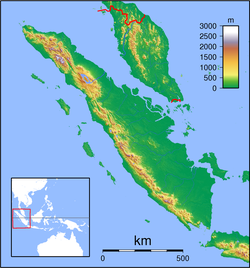2002 Sumatra earthquake
| Date | November 2, 2002 |
|---|---|
| Magnitude | 7.3 Mw |
| Depth | 30 km |
| Epicenter | 2°49′26″N 96°05′06″E / 2.824°N 96.085°ECoordinates: 2°49′26″N 96°05′06″E / 2.824°N 96.085°E |
| Areas affected | Sumatra, Indonesia |
| Max. intensity | VI (Strong) |
| Casualties | 3 |
The 2002 Sumatra earthquake occurred at 01:26 UTC on 2 November. It had a magnitude of 7.3 on the moment magnitude scale with an epicenter just north of Simeulue island and caused three deaths. This earthquake is regarded as a foreshock of the 2004 Indian Ocean earthquake, which had an epicenter about 60 km to the northwest.
The island of Sumatra lies on the convergent plate boundary between the Indo-Australian Plate and the Eurasian Plate. The convergence between these plates is highly oblique near Sumatra, with the displacement being accommodated by near pure dip-slip faulting along the subduction zone, known as the Sunda megathrust, and near pure strike-slip faulting along the Great Sumatran fault. The major slip events on the subduction zone interface are typically of megathrust type. Historically, great or giant megathrust earthquakes have been recorded in 1797, 1833, 1861, 2004, 2005 and 2007, most of them being associated with devastating tsunamis. Smaller (but still large) megathrust events have also occurred in the small gaps between the areas that slip during the larger events, in 1935, 1984, 2000 and 2002.
...
Wikipedia

